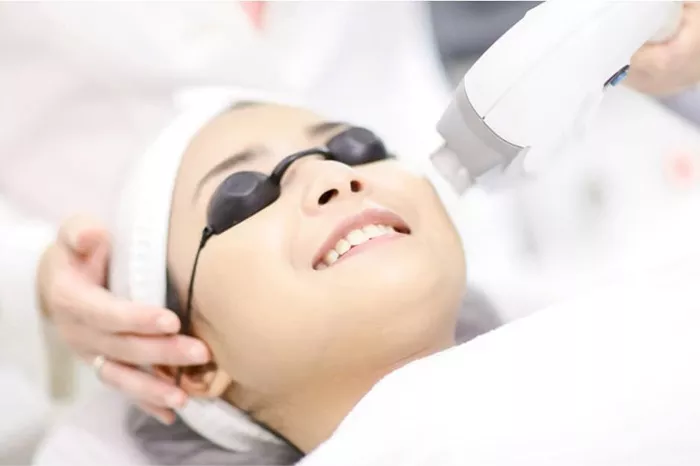Eye bags, also known as periorbital puffiness, are a common cosmetic concern. They appear as mild swelling or puffiness under the eyes. While they are generally not a medical issue, they can affect one’s appearance, leading to a tired or aged look.
Causes of Eye Bags
Several factors contribute to the development of eye bags:
Aging: As we age, the tissues around the eyes weaken, and fat that supports the eyes can move into the lower eyelids.
Fluid Retention: Changes in weather, hormone levels, and salty foods can cause fluid to accumulate under the eyes.
Lack of Sleep: Insufficient sleep can lead to the accumulation of fluid and dark circles under the eyes.
Allergies: Allergic reactions can cause inflammation and swelling around the eyes.
Genetics: Eye bags can be a hereditary trait.
Non-Invasive Treatments for Eye Bags
Lifestyle Changes
Sleep and Hydration
Adequate sleep and proper hydration are fundamental. Aim for 7-9 hours of sleep each night and drink plenty of water throughout the day to reduce puffiness.
Dietary Adjustments
Reducing salt intake can prevent fluid retention. Incorporating foods rich in vitamins A, C, and E can promote skin health.
Cold Compresses
Applying a cold compress can reduce swelling. Cold cucumbers, chilled spoons, or tea bags can be effective home remedies.
Topical Treatments
Eye Creams
Eye creams containing ingredients like caffeine, retinol, and hyaluronic acid can reduce puffiness and improve skin elasticity.
Caffeine: Helps to constrict blood vessels and reduce swelling.
Retinol: Promotes collagen production and skin renewal.
Hyaluronic Acid: Provides hydration and plumps the skin.
Cosmetic Procedures
Dermal Fillers
Dermal fillers, typically composed of hyaluronic acid, are injected into the under-eye area to add volume and smooth out puffiness. Results are immediate and can last several months.
Laser Therapy
Laser treatments, such as fractional laser resurfacing, can tighten skin and stimulate collagen production. This can reduce the appearance of eye bags and improve skin texture.
Radiofrequency Therapy
Radiofrequency (RF) therapy uses heat to stimulate collagen production and tighten skin. It’s a non-invasive procedure with minimal downtime.
Home Remedies
Cold Tea Bags
Applying cold tea bags can reduce puffiness. The caffeine and antioxidants in tea can help shrink blood vessels and reduce inflammation.
Cucumber Slices
Cucumber slices have a cooling effect that can reduce swelling and hydrate the skin.
Potato Slices
Potato slices contain enzymes that can lighten dark circles and reduce puffiness.
Professional Skincare Treatments
Chemical Peels
Chemical peels can remove dead skin cells and promote new skin growth, improving the appearance of the under-eye area.
Microdermabrasion exfoliates the skin, promoting new skin cell growth and reducing puffiness and dark circles.
Microneedling
Microneedling involves tiny needles that create micro-injuries in the skin, stimulating collagen and elastin production. This can improve skin texture and reduce the appearance of eye bags.
See also: How to prevent sagging eye bags?
Choosing the Right Treatment
Consultation with a Specialist
It’s essential to consult with a dermatologist or cosmetic specialist to determine the best treatment option. Factors such as skin type, severity of eye bags, and personal preferences play a significant role in choosing the right treatment.
Cost and Maintenance
Non-invasive treatments vary in cost and maintenance. It’s important to consider the financial aspect and the need for ongoing treatments to maintain results.
Potential Side Effects
While non-invasive treatments are generally safe, they can have side effects. These may include redness, swelling, and bruising. Always discuss potential risks with your healthcare provider.
Prevention Tips
1.Regular Skincare Routine
Maintaining a regular skincare routine with cleansing, moisturizing, and sun protection can help prevent the formation of eye bags.
2.Healthy Lifestyle
A healthy lifestyle that includes a balanced diet, regular exercise, and adequate sleep is crucial for overall skin health.
3.Avoiding Allergens
Identifying and avoiding allergens that can cause inflammation and puffiness around the eyes is essential. This may include dust, pollen, and certain skincare products.
4.Reducing Screen Time
Prolonged screen time can strain the eyes and contribute to the development of eye bags. Taking regular breaks and using blue light filters can help reduce eye strain.
Conclusion
Non-invasive treatments for eye bags offer various options for those looking to improve their appearance without undergoing surgery. From lifestyle changes and topical treatments to cosmetic procedures and professional skincare treatments, there are solutions to fit different needs and preferences. Consulting with a specialist is key to finding the most effective and suitable treatment. With proper care and maintenance, it is possible to reduce the appearance of eye bags and achieve a more youthful, refreshed look.
Related topics:
How To Get Rid Of Genetic Eye Bags?
How to get rid of eye bags using cucumber?


